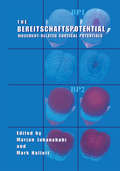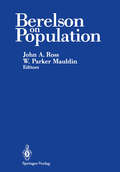- Table View
- List View
Bereitschaft zur Verantwortungsübernahme psychiatrisch Pflegender: Eine qualitative Studie (Best of Pflege)
by Dorothea SauterDorothea Sauter untersucht anhand der Auswertung von Gruppendiskussionen die Bereitschaft der Übernahme von Verantwortung bei psychiatrischen Pflegefachpersonen. Sie arbeitet zahlreiche Einflussfaktoren heraus und stellt Unterschiede zwischen der stationären und der ambulanten Pflege fest. Vor allem in psychiatrischen Kliniken fehlen etliche Voraussetzungen, damit Pflegefachpersonen im Interesse der Patienten Entscheidungen treffen können.
The Bereitschaftspotential: Movement-Related Cortical Potentials
by Marjan Jahanshahi Mark HallettKornhuber and Deecke first recorded and reported the Bereitschaftspotential in 1964. The aim of this book is to bring together in a single volume some of the important research on the Bereitschaftspotential and other movement-related cortical potentials and to highlight and address some of the pertinent questions relating to the Bereitschaftspotential and to identify the key issues for future investigation in this field. This book represents a unique compilation of information about the Bereitschaftspotential and related cortical potentials and techniques for measuring preparatory processes in the brain. The book will be of interest to motor physiologists, psychologists and neurologists working in clinical or research laboratories.
Berelson on Population
by W. ParkerMauldin John A. RossBernard (Barney) Berelson had a major influence in the application of social science concepts and methods to population policy during the period from 1962 to 1980. This was the period when concern with population problems spread from a relatively small group of scholars and population activists to a much larger, diverse, international group of political and intellectual leaders and to the general public as well. There was an exponential growth in the number of scholars and service personnel in vari ous population and family specialities in this period. Barney came into the field with his appointment as Director of the Com munication Research Program of The Population Council in 1962. He had no previous training or experience in demography. Frank Notestein, Presi dent of The Population Council at the time, had the wisdom to appreciate the value and relevance of Barney's itTIpressive background in communica tion research and other social science areas, as well as his creative mind and leadership qualities. His influence on the Council's rapidly expanding program was so immediate and impressive that within a year, he was named Vice President. When Frank Notestein retired in 1968, Barney became President, a post he held for 6 very productive years.
Bergey's Manual® of Systematic Bacteriology: Volume Two: The Proteobacteria, Part A Introductory Essays
by George GarrityIncludes introductory chapters on classification of prokaryotes, the concept of bacterial species, numerical and polyphasic taxonomy, bacterial nomenclature and the etymology of prokaryotic names, nucleic acid probes and their application in environmental microbiology, culture collections, and the intellectual property of prokaryotes. The first Road Map to the prokaryotes is included as well as an overview of the phylogenetic backbone and taxonomic framework for prokaryotic systematics.
Bergey's Manual® of Systematic Bacteriology: Volume 2: The Proteobacteria, Part B: The Gammaproteobacteria
by George GarrityIncludes a description of the Gammaproteobacteria (1203 pages, 222 figures, and 300 tables). This large taxon includes many well known medically and environmentally important groups. Especially notable are the Enterobacteriaceae, Aeromonas, Beggiatoa, Chromatium, Legionella, Nitrococcus, Oceanospirillum, Pseudomonas, Rickettsiella, Vibrio, Xanthomonas and 155 additional genera.
Bergey's Manual® of Systematic Bacteriology: Volume 2: The Proteobacteria, Part B: The Gammaproteobacteria
by George GarrityIncludes a description of the Gammaproteobacteria (1203 pages, 222 figures, and 300 tables). This large taxon includes many well known medically and environmentally important groups. Especially notable are the Enterobacteriaceae, Aeromonas, Beggiatoa, Chromatium, Legionella, Nitrococcus, Oceanospirillum, Pseudomonas, Rickettsiella, Vibrio, Xanthomonas and 155 additional genera.
Bergey's Manual of Systematic Bacteriology: Volume One : The Archaea and the Deeply Branching and Phototrophic Bacteria
by George M. GarrityBacteriologists from all levels of expertise and within all specialties rely on this Manual as one of the most comprehensive and authoritative works. Since publication of the first edition of the Systematics, the field has undergone revolutionary changes, leading to a phylogenetic classification of prokaryotes based on sequencing of the small ribosomal subunit. The list of validly named species has more than doubled since publication of the first edition, and descriptions of over 2000 new and realigned species are included in this new edition along with more in-depth ecological information about individual taxa and extensive introductory essays by leading authorities in the field.
Bergey's Manual of Systematic Bacteriology: Volume One : The Archaea and the Deeply Branching and Phototrophic Bacteria
by George M. GarrityBergey's Manual of Systematic Bacteriology: Volume 3: The Firmicutes (Bergey's Manual Of Systematic Bacteriology (springer-verlag) Ser.)
by George M. Garrity Karl-Heinz Schleifer Noel R. Krieg Fred A. Rainey Dorothy Jones Wolfgang Ludwig William B. Whitman Paul VosOne of the most authoritative works in bacterial taxonomy, this resource has been extensively revised. This five volume second edition has been reorganized along phylogenetic lines to reflect the current state of prokaryotic taxonomy. In addition to the detailed treatments provided for all of the validly named and well-known species of prokaryotes, this edition includes new ecological information and more extensive introductory chapters.
Bergey's Manual® of Systematic Bacteriology: Volume Two: The Proteobacteria (Part C)
by George Garrity James T. Staley David R. Boone Don J. Brenner Paul De Vos Michael Goodfellow Noel R. Krieg Fred A. Rainey Karl-Heinz SchleiferIncludes a description of the Alpha-, Beta-, Delta-, and Epsilonproteabacteria (1256 pages, 512 figures, and 371 tables). This large taxa include many well known medically and environmentally important groups. Especially notable are Acetobacter, Agrobacterium, Aquospirillum, Brucella, Burkholderia, Caulobacter, Desulfovibrio, Gluconobacter, Hyphomicrobium, Leptothrix, Myxococcus, Neisseria, Paracoccus, Propionibacter, Rhizobium, Rickettsia, Sphingomonas, Thiobacillus, Xanthobacter and 268 additional genera.
Bergey's Manual of Systematic Bacteriology: Volume 5: The Actinobacteria
by Aidan ParteIncludes a revised taxonomic outline for the Actinobacteria or the high G+C Gram positives is based upon the SILVA project as well as a description of greater than 200 genera in 49 families. Includes many medically and industrially important taxa.
Bergey's Manual of Systematic Bacteriology: Volume 4: The Bacteroidetes, Spirochaetes, Tenericutes (Mollicutes), Acidobacteria, Fibrobacteres, Fusobacteria, Dictyoglomi, Gemmatimonadetes, Lentisphaerae, Verrucomicrobia, Chlamydiae, and Planctomycetes (Bergey's Manual Of Systematic Bacteriology (springer-verlag) Ser.)
by Aidan ParteIncludes a revised taxonomic outline for the phyla Bacteroidetes, Planctomycetes, Chlamydiae, Spirochetes, Fibrobacteres, Fusobacteria, Acidobacteria, Verrucomicrobia, Dictyoglomi, and Gemmatimonadetes based upon the SILVA project as well as a description of more than 153 genera in 29 families. Includes many medically important taxa.
Bergey's Manual of Systematic Bacteriology: Volume 4: The Bacteroidetes, Spirochaetes, Tenericutes (Mollicutes), Acidobacteria, Fibrobacteres, Fusobacteria, Dictyoglomi, Gemmatimonadetes, Lentisphaerae, Verrucomicrobia, Chlamydiae, and Planctomycetes
by Aidan ParteIncludes a revised taxonomic outline for the phyla Bacteroidetes, Planctomycetes, Chlamydiae, Spirochetes, Fibrobacteres, Fusobacteria, Acidobacteria, Verrucomicrobia, Dictyoglomi, and Gemmatimonadetes based upon the SILVA project as well as a description of more than 153 genera in 29 families. Includes many medically important taxa.
Bergey's Manual of Systematic Bacteriology: Volume 5: The Actinobacteria
by Aidan ParteIncludes a revised taxonomic outline for the Actinobacteria or the high G+C Gram positives is based upon the SILVA project as well as a description of greater than 200 genera in 49 families. Includes many medically and industrially important taxa.
Bergey's Manual of Systematic Bacteriology: Volume 3: The Firmicutes
by Paul Vos, George M. Garrity, Dorothy Jones, Noel R. Krieg, Wolfgang Ludwig, Fred A. Rainey, Karl-Heinz Schleifer and William B. WhitmanIncludes a revised taxonomic outline for the Firmicutes based upon the SILVA project as well as a description of more than 1346 species and 235 genera belonging to the phylum Firmicutes, which are also called the low mol% G+C Gram positive prokaryotes. Major taxa to be included are Alicyclobacillus, Bacillus, Clostridium, Enterococcus, Erysipelothrix, Eubacterium, Haloanaerobium, Heliobacterium, Lachnospira, Lactobacillus, Leuconostoc, Listeria, Paenibacillus, Peptococcus, Ruminococcus, Staphylococcus, Streptococcus, Syntrophomonas, Thermoactinomyces, Thermoanaerobacter, Veillonella and 229 additional genera. Includes many medically and industrially important taxa.
Bergey's Manual® of Systematic Bacteriology: Volume Two: The Proteobacteria (Part C)
by James T. Staley George Garrity David R. Boone Don J. Brenner Paul De Vos Michael Goodfellow Noel R. Krieg Fred A. Rainey Karl-Heinz SchleiferIncludes a description of the Alpha-, Beta-, Delta-, and Epsilonproteabacteria (1256 pages, 512 figures, and 371 tables). This large taxa include many well known medically and environmentally important groups. Especially notable are Acetobacter, Agrobacterium, Aquospirillum, Brucella, Burkholderia, Caulobacter, Desulfovibrio, Gluconobacter, Hyphomicrobium, Leptothrix, Myxococcus, Neisseria, Paracoccus, Propionibacter, Rhizobium, Rickettsia, Sphingomonas, Thiobacillus, Xanthobacter and 268 additional genera.


















